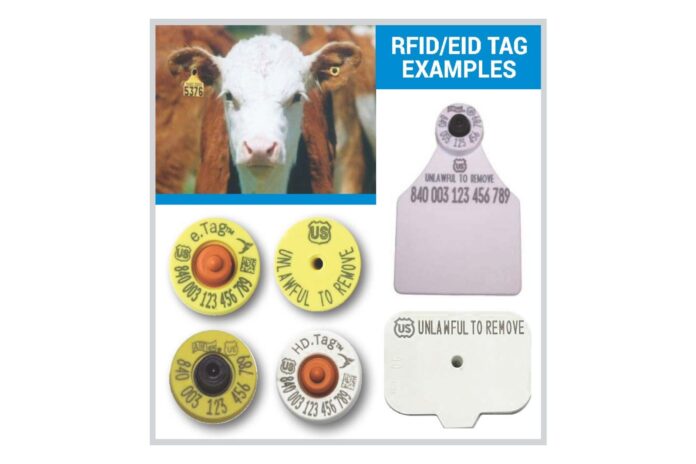
SALEM, Ohio — The U.S. Department of Agriculture Animal and Plant Health Inspection Service’s updated animal disease traceability rule goes into effect Nov. 5. That’s when all official ear tags for cattle and bison must be both visually and electronically readable.
The goal is to create a modern system that quickly tracks animals from birth to slaughter, preventing disease spread. While advocates see it as essential for protecting herd health and U.S. beef markets, critics argue it imposes financial burdens on farmers and raises concerns about privacy and government overreach.
Despite the debate, some state officials remain steadfast in their commitment to the rule.
“At the Ohio Department of Agriculture, animal health and disease traceability are a top priority,” said Ohio Director of Agriculture Brian Baldridge in a statement to Farm and Dairy.
“Protecting and promoting the health of our state’s livestock and poultry industries play a critical role in keeping our food supply safe for all Ohioans,” he said, adding that the agency will continue to work with industry producers to ensure the rule is upheld.
The rule
Adult cattle and bison that are sexually intact and at least 18 months old must have ear tags that can be read both electronically and visually in order to cross state lines. This also goes for cattle and bison that are used for rodeos, shows, exhibitions and recreational events. Electronic tags are required for all dairy cattle and beef or dairy crossbred cattle for interstate travel, no matter what age, gender or current use, as well as their calves.
Cattle and bison are exempted from official identification requirements if they are going directly to slaughter.
APHIS said in a fact sheet that animals with visual-only official identity tags applied before Nov. 5 do not need an electronically readable tag. All visual-only identification tags applied to cattle and bison before the rule goes into effect are considered sufficient identification for the animal’s lifetime.
According to APHIS, the revised rule focuses on developing an efficient and accurate traceability system to reduce the number of animals and reaction time engaged in disease investigations, thereby reducing the economic impact on owners and affected communities.
Opposition
That’s not how David Hyde, a cow-calf producer from Jefferson County, Ohio, sees it. Hyde, a regional director of the Ranchers-Cattlemen Action Legal Fund United Stockgrowers of America, or R-CALF USA, said that the new tagging requirement is just one part of an overarching government strategy to increase control over agriculture, eroding the independence of small cattle operations.
Hyde said the rule is like a runaway horse with three goals: To eliminate, consolidate, and control the cattle industry.
“Why?” He said. “It’s because we’re the last remaining independent protein producers not under the control of the multinational corporations.”
Part of his concern is that small producers like himself will be disadvantaged compared to imported beef that doesn’t face strict tracking requirements. He fears producers like him will eventually be forced out of business when they’re denied access to the interstate market for cattle that don’t comply with the mandate.
It’s a view shared by Congresswoman Harriet Hageman (R-Wy.), who introduced legislation that would block the Department of Agriculture’s electronic ID mandate.
“It is obvious that, while the implementation of this rule would provide an outsized benefit to large corporations, it would provide nothing but a burden to smaller producers,” she said during remarks at the Livestock Producers’ Freedom Rally, hosted by the United States Cattlemen’s Association and R-CALF USA, held Oct. 7 in South Dakota. “The consolidation of power in the hands of a few, at the expense of small and independent farmers and ranchers is a threat to our entire food supply.”
Bill Bullard, CEO of R-CALF USA, told Farm and Dairy the organization is within days of filing a lawsuit to get a restraining order against the electronic ID mandate.
By the USDA’s own account, animal disease tracking efforts in the U.S. have proven effective in the past without electronic ID tagging. APHIS has used metal, non-electronic identification tags for animal identification in disease programs for decades and has approved both non-EID and EID tags for use as official ear tags in cattle and bison since 2008.
The agency successfully traced a case of BSE, or mad cow disease, to an animal in Washington in December 2003. Hyde believes that the system as it stands is adequate.
“A tool in the toolbox”
Elizabeth Harsh, executive director of the Ohio Cattlemen’s Association, views the USDA’s tracking rule differently, believing the electronic ID tags are vital for protecting both the cattle industry and the U.S. economy. She said the association’s board has been closely engaged in the animal disease traceability discussion for several years.
“We are supportive of this simply because it is about protecting the health of our herd and our markets,” she said. “If we look at the tremendous live cattle prices that producers have been experiencing compared to some of our commodities, and a strong consumer demand, we need to do everything we can to see that continue.”
Harsh emphasized the importance of export markets, noting that each fed animal in the U.S. generates at least $400 from exports. She warned that an outbreak of a foreign animal disease, such as foot-and-mouth, could threaten this revenue, making effective disease tracing essential to protecting the industry’s economic stability.
According to Harsh, misinformation fuels much of the opposition.
“I think sometimes the controversy exists simply because it’s in places where there’s a lack of information or facts,” she said, emphasizing that the updated rule doesn’t change which classes of cattle need tagging—only that tags now must be electronically readable.
To Harsh, the rule is a necessary modernization to keep up with the speed at which cattle move across the country and ensure quick responses to potential outbreaks.
“It is just a data point that says that animal was here at this time when that tag was scanned,” she said. “It’s one data point. It’s a tool in a toolbox.”
The National Cattlemen’s Beef Association shares a similar stance. Hunter Ihrman, the NCBA’s director of policy communications, highlighted the necessity of the rule for maintaining biosecurity in the beef supply chain.
“The ADT rule is a federal regulatory requirement. NCBA engaged in the rulemaking process to advocate for our members’ priorities,” Ihrman wrote in an email to Farm and Dairy.
He said that while electronic ID tags are part of the government’s ADT framework, other initiatives like the Secure Beef Supply Plan — a voluntary biosecurity framework — also contribute to safeguarding the industry.
The tags
The low-frequency electronic tags, also known as RFID or 840 tags, are intended only for cattle. They pose no risk to personal information as they don’t store or transmit data. Powered solely by an RFID reader’s radio signal, the tags emit a response when scanned, with no internal power source or batteries needed.
The tags require a Premises Identification Number (PIN) before use. For Ohioans, registration for a PIN number begins on the Ohio Department of Agriculture’s website.
Outside of state veterinarian offices, vendors such as Allflex and Valley Vet Supply are among those offering USDA-compliant animal traceability badges for sale online. Bulk purchases of the tags can cost anywhere from $20 to $100. For a full list of approved manufacturer devices including tags for all species, go here.
The USDA emphasized that a limited number of official tags are available to each state for distribution until they run out. Earlier this year, Congress approved $15 million for electronic ID tags with a limited number made available to producers for free through state veterinarian’s offices. However, in the text of the final rule, APHIS wrote that “we acknowledge that producers may at some point have to assume costs associated with purchasing electronic ID tags as a result of this rulemaking.”
The agency estimates the cost of implementing the full-scale electronic ID tagging system to be approximately $26.1 million, leaving a significant funding gap in the absence of additional federal support.
A spokesperson for the Ohio Department of Agriculture said there are about 55,000 tags currently available for producers to request for use in cattle.
Skepticism
Hyde expressed skepticism about the government’s true intentions, calling the rule a “foot in the door” for further regulations. He cited examples from abroad, including Denmark’s $96 per cow tax to reduce greenhouse gas emissions, and Ireland’s 2022 mandate requiring electronic ID tags for newborn calves.
A year later, Hyde said, “they came out and told the farmers how many they had to get rid of for global warming.”
In Ireland, the Department of Agriculture proposed killing up to 200,000 cows to cut methane emissions, but by April 2023, an Irish official told the UK-based Dairy Reporter that the plan was effectively “off the table.”
There is no clear link between electronic ID tags and the abandoned cow culling plan, but Congresswoman Hageman connected the two herself in a July press release. She cited Ireland’s electronic ID mandate and subsequent livestock reduction as proof of “the threat of a USDA-driven electronic ID mandate,” saying “a mandatory electronic ID simply gives the federal government too much power.”
Hyde, echoing claims from social media, alleged that the USDA paid the NCBA nearly half a million dollars last year to promote electronic ID tags. However, according to Ihrman, the NCBA spokesman, $445,396 was awarded to NCBA for the Secure Beef Supply Plan, unrelated to the electronic ID rule, and was used solely for outreach and education about foot-and-mouth disease preparedness.
He emphasized that “USDA prohibits any of these funds from being used to engage on policy issues” like electronic ID tags.










I fully understand producer’s skepticism on this program and it’s REAL purposes, as, by the USDA’s own admission, the current tag system is working. As the old saying goes, “if it ain’t broke, why fix it?”